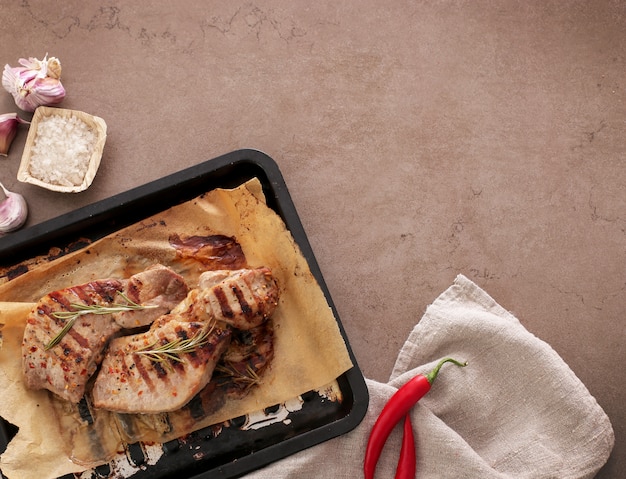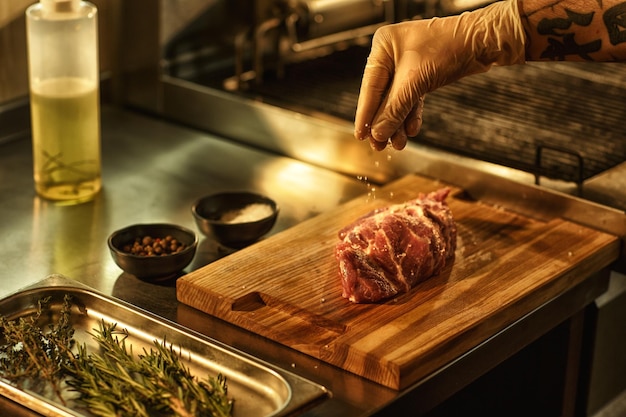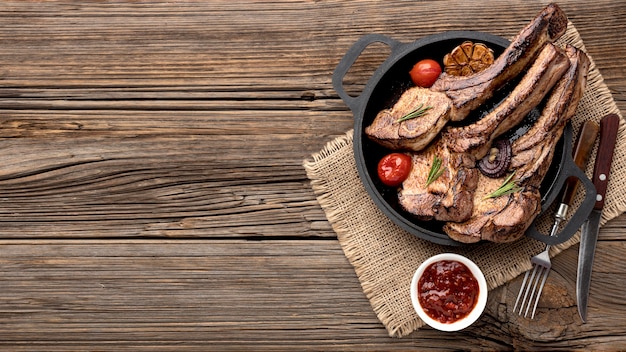Ah, the humble lamb roast. There's something truly special about it, isn't there? It’s a dish that screams comfort and celebration, especially when you've got a table full of hungry guests. And let's be honest, the aroma of a perfectly roasted lamb wafting through your home is enough to make anyone's mouth water. Over the years, I've cooked my fair share of lamb roasts, and I’ve learned a thing or two about making them truly unforgettable. So, grab your apron, put on some good music, and let's get started!
(Part 1) Choosing Your Lamb - The Foundation of a Great Roast

The Cut: Unlocking Flavor and Texture
First things first, we need to talk about the cut. And here's the thing: it's all about what you're after. For me, the shoulder is the ultimate choice. It's full of flavour, thanks to the lovely marbling, and it's a bit more forgiving for those who aren't quite as experienced in the kitchen. It can handle a longer cooking time without drying out, which is a real plus, especially when you're catering to a crowd.
If you're looking for something leaner, the leg is a great option. But be warned: it needs a bit more TLC to avoid becoming dry. It’s a bit of a balancing act, but the payoff is worth it – a lean and tender roast that’s perfect for those who prefer a lighter cut.
Then there’s the loin, perfect for a quick and succulent roast. It's a bit more delicate, ideal for a smaller gathering where you want to impress with a juicy and flavorful piece of meat.
Ultimately, it’s all about preference. Consider what you're looking for in terms of flavour, texture, and cooking time. And don't be afraid to experiment! Each cut has its own unique charm, and there's no single "best" choice.
Boneless or Bone-In: A Choice of Convenience or Tradition
Now, let's talk about the bone. Boneless roasts are a lifesaver for those who love convenience. They cook quicker and offer a clean, uniform presentation. But let's be honest, there's something special about a bone-in roast. It’s traditional, it looks stunning, and the bone itself contributes to a more flavourful, moist, and tender roast.
The bone acts like a little heat conductor, helping the meat cook evenly and stay juicy. It also adds that lovely, classic roast flavour. So, if you're after a traditional experience and a truly flavorful roast, go for the bone-in. But if convenience and speed are your priorities, the boneless option won’t disappoint.
Size Matters: Matching Your Roast to Your Crowd
Alright, now for the big question: how much lamb do you need? This is crucial for avoiding any awkward moments with your guests. For a smaller gathering, a 1.5kg roast should be more than enough to satisfy everyone. But for a larger crowd, you might want to go for something closer to 2.5kg. The important thing is to calculate the weight based on the number of people you're serving.
Don’t worry if you’re a little unsure about the size. Most butchers will be happy to advise you based on your needs and preferences. Just be sure to check the label and make sure you’re getting the right size for your occasion.
(Part 2) Getting Ready to Roast: Preparing for Culinary Magic

The Right Temperature: A Balance of Heat and Patience
Now that you've chosen your lamb, let's talk about the temperature. This is key for achieving that beautiful, crispy exterior while keeping the inside juicy and tender. A high temperature, around 220°C (425°F), is crucial for the first stage of cooking. It helps to seal in those precious juices and create that gorgeous golden-brown crust.
But remember, you can't just blast the lamb with intense heat for the entire cooking time. Once you've achieved that beautiful browning, it's time to reduce the heat to around 160°C (325°F). This gentler heat will allow the lamb to cook through evenly, without drying it out.
Seasoning Secrets: Unleashing the Flavors of the Roast
Let’s talk about seasoning – the magic touch that transforms a simple roast into something truly extraordinary. A simple mix of salt and pepper will always do the trick, but I love adding a little smoky paprika for an extra depth of flavour. It adds a lovely warmth and complexity that’s hard to resist.
Experiment with different herbs, like rosemary, thyme, or even a pinch of garlic powder. It’s all about finding your personal touch. Remember, the key is to season generously but avoid overdoing it. You want to enhance the natural flavour of the lamb, not mask it.
The Importance of Resting: Allowing the Flavors to Settle
This is a step that many people overlook, but it’s absolutely crucial for creating a truly delicious lamb roast. After cooking your lamb, resist the urge to carve it right away. Give it at least 15 minutes to rest. This might seem like an eternity, but it’s a vital step that makes all the difference.
During the resting period, the internal juices redistribute throughout the meat. This ensures that each bite is juicy and flavorful. Cover the lamb loosely with foil to keep it warm and prevent it from drying out. Trust me, the extra time is well worth it!
(Part 3) Mastering the Roast: The Art of Culinary Precision

The Art of Roasting: Creating a Culinary Masterpiece
Alright, let’s get down to business. It's time to roast! I find a roasting pan is the way to go for a more even cook. It helps to distribute the heat evenly and catch those luscious pan juices. If you’re using a rack, make sure it’s raised off the bottom of the pan to allow air to circulate freely.
Place your seasoned lamb in the preheated oven and let it cook, checking the temperature regularly. Cooking times vary depending on the size and weight of your roast, so it's always best to check the recipe you’re following.
Don't Overcook It! The Secret to a Tender and juicy roast
The golden rule of lamb roasting is to avoid overcooking it. Nobody likes a dry and tough roast! That's where a trusty meat thermometer comes in handy. It’s your best friend in the kitchen. For medium-rare, aim for an internal temperature of around 55°C (130°F). If you prefer it medium, go for around 60°C (140°F). And if you like your lamb well-done, cook it until it reaches 70°C (160°F).
Personally, I love my lamb a bit pink, with a tender, juicy center. But ultimately, it’s all about your preference. Just make sure you check the temperature regularly and take it out of the oven when it reaches your desired level of doneness.
Basting for a Juicy Finish: Enhancing Flavor and Moisture
Now, for the final touch: basting. This is an essential step for a truly luscious lamb roast. It helps to keep the meat moist, lock in the flavour, and create a beautiful, glossy finish. You can use the pan juices, or you can get fancy and create a mixture of butter and herbs.
But remember, don't baste too often. Excessive basting can actually cause the meat to steam instead of roast, leading to a less flavorful result. A good rule of thumb is to baste once every 30 minutes.
(Part 4) Gorgeous Garnishes: Completing Your Culinary Creation
Let's talk about the side dishes, those culinary companions that make your lamb roast shine even brighter. Roasted vegetables are a classic pairing for a reason. Potatoes, carrots, and parsnips are perfect for soaking up all those delicious pan juices, creating a symphony of textures and flavours.
I always add a side of green beans or peas for a touch of freshness and vibrant colour. And don’t forget a refreshing green salad to balance out the richness of the lamb. It's the perfect finishing touch.
A Touch of Luxury: Elevate Your Roast with Extra Flair
Feeling a bit fancy? Try adding some sprigs of rosemary or garlic cloves to the roasting pan. They release their aromas as they cook, adding a lovely depth of flavour to the lamb. Or, take it a step further and create a delicious gravy from the pan juices. Just add a splash of wine and thicken it with flour. It’s simple, but it makes a world of difference.
Mint Sauce: A Classic Pairing
No lamb roast is complete without a good mint sauce. It's a classic pairing for a reason. Its refreshing flavour cuts through the richness of the lamb, creating a delightful balance. You can buy it ready-made, but it's incredibly easy to whip up your own. Simply combine fresh mint, sugar, vinegar, and a touch of water.
(Part 5) The Grand Finale: Presenting Your Culinary Triumph
Carving the Roast: Unveiling the Beauty Within
Alright, it's time for the grand reveal! After resting, it's time to carve your lamb. Use a sharp knife and carve against the grain, creating thin, even slices. I like to leave the bone in for presentation, but you can remove it if you prefer. It's all about your personal style.
Presentation is Key: A Feast for the Eyes
Arrange your beautifully carved lamb on a platter, surrounded by your chosen vegetables. Garnish with rosemary sprigs for a touch of elegance. Then, serve with a generous spoonful of mint sauce, and watch as your guests marvel at your culinary masterpiece.
(Part 6) Flavour Variations: Exploring the World of Lamb
We've covered the basics, but let's explore some exciting flavour variations to take your lamb roast to the next level.
Mediterranean Flair: A Taste of the Sunny South
For a taste of the Mediterranean, rub the lamb with a mixture of olive oil, lemon juice, garlic, oregano, and thyme. The combination of fresh herbs and citrus creates a vibrant and fragrant flavour that will transport your guests to a sunny beach. You could even add some roasted tomatoes and peppers to the roasting pan for extra flavour.
Asian Inspiration: A Fusion of Flavors
Want to try something a bit different? Try a Chinese-inspired lamb roast. Marinate the lamb in a mixture of soy sauce, honey, ginger, and garlic. The combination of sweet and savory flavors, with a touch of ginger's heat, creates a unique and delicious taste. Roast it with sliced onions and peppers, and serve with a dipping sauce of soy sauce, rice vinegar, and sesame oil. It’s a fantastic way to introduce your guests to a new culinary experience.
Spicy Kick: Adding a Touch of Heat
For those who love a bit of heat, try rubbing the lamb with a spicy rub. Combine chili powder, cumin, paprika, and garlic for a blend of flavour and heat. You could also add some jalapeno peppers to the roasting pan for extra spice. Just remember, start with a little bit of spice and adjust to your liking!
(Part 7) Lamb roast recipes: A Collection of Culinary Delights
Now, let's dive into some specific recipes that will inspire you to create your own culinary masterpiece.
roast lamb with Rosemary and Garlic: A Classic with a Touch of Charm
This is a classic recipe for a reason. The rosemary and garlic infuse the lamb with a rich, savory flavour that’s simply irresistible. The combination of herbs and garlic creates a timeless and aromatic flavour that’s sure to please even the most discerning palates. Find this recipe on my website, [insert website link].
Slow-Cooked Lamb Roast: Tenderness and Flavor at Its Best
For a truly tender and juicy lamb roast, try slow-cooking it in the oven. The low and slow method ensures that the meat cooks through perfectly, resulting in a melt-in-your-mouth experience. I've got a delicious recipe for slow-cooked lamb with red wine and herbs on my website: [insert website link].
Lamb Roast with Apricot and Almond Glaze: A Culinary Masterpiece
This is a truly elegant recipe that’s perfect for special occasions. The apricot and almond glaze adds a touch of sweetness and richness to the lamb, creating a beautiful balance of flavors. Find this recipe on my website: [insert website link].
(Part 8) FAQs: Addressing Your Culinary Queries
Now, let's address some common questions that might be buzzing around your mind as you prepare to embark on your lamb roast adventure.
What are the best cuts of lamb for roasting?
The best cuts of lamb for roasting are the shoulder, leg, and loin. The shoulder is a good choice for a more forgiving roast, while the leg is a leaner option. The loin is ideal for a quick and succulent roast. Choose the cut that best suits your preferences and the occasion.
How do I know when my lamb is cooked?
Use a meat thermometer to check the internal temperature of your lamb. For medium-rare, aim for 55°C (130°F). Medium is around 60°C (140°F), and well-done is about 70°C (160°F). The best way to determine doneness is to rely on the thermometer and your own preferences.
What should I serve with lamb roast?
Classic accompaniments for lamb roast include roasted vegetables, such as potatoes, carrots, and parsnips. A side of green beans or peas adds some freshness, and a vibrant green salad is a must. You can also serve mint sauce, gravy, or a dipping sauce. There are endless possibilities for pairing your roast with delicious sides.
How do I store leftover lamb?
Leftover lamb can be stored in an airtight container in the refrigerator for up to 3 days. You can use it in sandwiches, salads, or pies. Get creative with your leftovers!
Can I freeze lamb roast?
Yes, you can freeze lamb roast. Wrap it tightly in plastic wrap and aluminum foil, and freeze for up to 3 months. To thaw, place the lamb in the refrigerator overnight.
So there you have it, my friends! The ultimate guide to cooking a perfect lamb roast. Remember, it's all about choosing the right cut, seasoning it well, and cooking it to perfection. With a little practice, you'll be creating delicious lamb roasts that everyone will love. Happy cooking!
Everyone is watching

Corn on the Cob: The Ultimate Guide to Perfectly Cooked Ears
Healthy MealsAh, corn on the cob. Just the name evokes images of sunny days, barbecues, and that sweet, juicy flavour that ...

Scallops: The Ultimate Guide to Perfect Cooking
Healthy MealsAh, scallops. Those delicate, sweet, and utterly delicious morsels of the sea. They hold a special place in my...

Spaghetti Squash: The Ultimate Guide to Cooking and Serving
Healthy MealsRemember that time you saw spaghetti squash at the supermarket, looking all bumpy and strange, and thought, "W...

Salmon Cooking Times: Perfect Guide for Every Recipe
Healthy MealsLet me tell you, cooking salmon is an art form. It's all about getting that perfect balance: juicy and tender,...

Ham Cooking Time: How Long to Bake, Smoke, or Boil a Delicious Ham
Healthy MealsAh, ham. It's a classic, isn't it? A real crowd-pleaser, especially around holidays. And when done right, it'...
